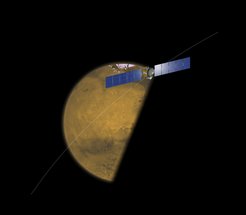A rehearsal in space
The up-coming Mars swing-by offers the camera system aboard NASA’s space probe DAWN a challenging testing opportunity.
After its 17 month long journey through space NASA’s mission DAWN is expecting a change of pace: On Wednesday, February 18th, the probe will swing-by Mars in order to pick up speed and correct its course. For the cameras aboard DAWN that were build under the leadership of the Max Planck Institute for Solar System Research in Germany this is the first and last rehearsal. Until the space probe reaches its first scientific goal, the asteroid Vesta, in 2011 there will be no comparable opportunity to test the instruments.

“The distant stars that the cameras usually record during their journey show up as only tiny pixels on our pictures”, explains Dr. Holger Sierks, head of the camera team. This can not be compared to the situation that the camera will encounter on arrival at the asteroid Vesta, when the motif will be very close. Only the Mars swing-by offers a similar setting. “During the swing-by we can produce pictures, that are not possible elsewhere”, says Sierks.
Approximately three hours before DAWN reaches its shortest distance to Mars on Wednesday, February 18th, at 0.27 UTC, the camera system will be turned on. It will continue to operate for around a week. The scientists from the Max Planck Institute for Solar System Research who will be following the maneuver at the DAWN Science Center in Los Angeles intend to use this time to test the instrument extensively and prepare it for its future tasks. For example, they want to study, how the cameras’ optics react to stray light. Impressive pictures of Mars that may be taken during the tests are a welcome by-product.
“We hope, that the camera system will deliver several images of the red planet”, says Sierks. Until they can get an overview over the pictures, the scientists will however have to be patient. It will take about a week to transmit all data from the satellite to Earth.
NASA’s mission DAWN has been travelling to a region in space beyond Mars that scientists refer to as the asteroid belt since September 2007. On arrival the probe will accompany two of the many asteroids that circle the Sun there in an orbit between Mras and Jupiter and that give this region its name for a few months each: In August 2011 DAWN will reach the asteroid Vesta and in February 2015 it will reach the asteroid Ceres. The up-coming Mars swing-by is the only planned swing-by until then.
The camera system aboard the space probe consists of two identical cameras that cover all wavelengths between the visible blue light and the infrared. In case one of the cameras fails, the other one can replace it easily. The cameras were developed by the German Max Planck Institute for Solar System Research together with the German Space Agency (DLR) and the Institute of Computer and Network Engineering of the Technical University in Braunschweig.
Asteroids enable scientists to take a glance at an early stage of the solar system. About 4.5 billion years ago these tiny planets were trapped between the gravitational forces of Jupiter and the Sun. They could therefore not evolve into larger planets. The asteroids conserve a state that cannot be studied in any other part of the solar system.
